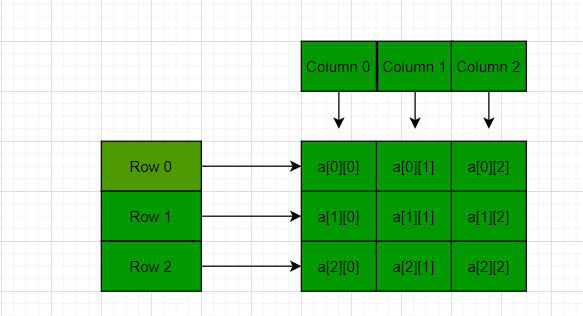How to declare a 2D array dynamically in C++ using new operator (original) (raw)
Last Updated : 14 Sep, 2022
Prerequisite: Array Basics
In C/C++, multidimensional arrays in simple words as an array of arrays. Data in multidimensional arrays are stored in tabular form (in row major order). Below is the general form of declaring N-dimensional arrays:
Syntax of a Multidimensional Array:
data_type array_name[size1][size2]….[sizeN];
data_type: Type of data to be stored in the array.
Here data_type is valid C/C++ data type
array_name: Name of the array
size1, size2, …, sizeN: Sizes of the dimensions
2D arrays are arrays of single-dimensional arrays.
Syntax of a 2D array:
data_type array_name[x][y];
data_type: Type of data to be stored. Valid C/C++ data type.
Below is the diagrammatic representation of 2D arrays:
For more details on multidimensional and 2D arrays, please refer to Multidimensional arrays in C++ article.
Problem: Given a 2D array, the task is to dynamically allocate memory for a 2D array using new in C++.
Solution: Following 2D array is declared with 3 rows and 4 columns with the following values:
1 2 3 4 5 6 7 8 9 10 11 12
Note: Here M is the number of rows and N is the number of columns.
Method 1: using a single pointer - In this method, a memory block of size M*N is allocated and then the memory blocks are accessed using pointer arithmetic. Below is the program for the same:
C++ `
// C++ program to dynamically allocate // the memory for 2D array in C++ // using new operator #include using namespace std;
// Driver Code int main() { // Dimensions of the 2D array int m = 3, n = 4, c = 0;
// Declare a memory block of
// size m*n
int* arr = new int[m * n];
// Traverse the 2D array
for (int i = 0; i < m; i++) {
for (int j = 0; j < n; j++) {
// Assign values to
// the memory block
*(arr + i * n + j) = ++c;
}
}
// Traverse the 2D array
for (int i = 0; i < m; i++) {
for (int j = 0; j < n; j++) {
// Print values of the
// memory block
cout << *(arr + i * n + j)
<< " ";
}
cout << endl;
}
//Delete the array created
delete[] arr;
return 0;}
`
Output:
1 2 3 4 5 6 7 8 9 10 11 12
Method 2: using an array of pointer: Here an array of pointers is created and then to each memory block. Below is the diagram to illustrate the concept:
Below is the program for the same:
C++ `
// C++ program to dynamically allocate // the memory for 2D array in C++ // using new operator #include using namespace std;
// Driver Code int main() { // Dimensions of the array int m = 3, n = 4, c = 0;
// Declare memory block of size M
int** a = new int*[m];
for (int i = 0; i < m; i++) {
// Declare a memory block
// of size n
a[i] = new int[n];
}
// Traverse the 2D array
for (int i = 0; i < m; i++) {
for (int j = 0; j < n; j++) {
// Assign values to the
// memory blocks created
a[i][j] = ++c;
}
}
// Traverse the 2D array
for (int i = 0; i < m; i++) {
for (int j = 0; j < n; j++) {
// Print the values of
// memory blocks created
cout << a[i][j] << " ";
}
cout << endl;
}
// Delete the array created
for (int i = 0; i < m; i++) // To delete the inner
// arrays
delete[] a[i];
delete[] a; // To delete the outer array
// which contained the pointers
// of all the inner arrays
return 0;}
`
Output:
1 2 3 4 5 6 7 8 9 10 11 12

